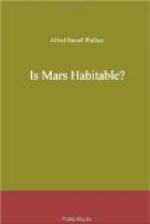But in the case of Mars the progress of discovery has had a very different result. The most obvious peculiarity of this planet—its polar snow-caps—were seen about 250 years ago, but they were first proved to increase and decrease alternately, in the summer and winter of each hemisphere, by Sir William Herschell in the latter part of the eighteenth century. This fact gave the impulse to that idea of similarity in the conditions of Mars and the earth, which the recognition of many large dusky patches and streaks as water, and the more ruddy and brighter portions as land, further increased. Added to this, a day only about half an hour longer than our own, and a succession of seasons of the same character as ours but of nearly double the length owing to its much longer year, seemed to leave little wanting to render this planet a true earth on a smaller scale. It was therefore very natural to suppose that it must be inhabited, and that we should some day obtain evidence of the fact.
The Canals discovered by Schiaparelli.
Hence the great interest excited when Schiaparelli, at the Milan Observatory, during the very favourable opposition of 1877 and 1879, observed that the whole of the tropical and temperate regions from 60 deg. N. to 60 deg. S. Lat. were covered with a remarkable network of broader curved and narrower straight lines of a dark colour. At each successive favourable opposition, these strange objects called canali (channels) by their discoverer, but rather misleadingly ‘canals’ in England and America, were observed by means of all the great telescopes in the world, and their reality and general features became well established. In Schiaparelli’s first map they were represented as being much broader and less sharply defined than he himself and other observers found by later and equally favourable observations that they really were.
Discovery of the Double Canals.
In 1881 another strange feature was discovered by Schiaparelli, who found that about twenty canals which had previously been seen single were now distinctly double, that is, that they consisted of two parallel lines, equally distinct and either very close together or a considerable distance apart. This curious appearance was at first thought to be due to some instrumental defect or optical illusion; but as it was soon confirmed by other observers with the best instruments and in widely different localities it became in time accepted as a real phenomenon of the planet’s surface.
Round Spots discovered in 1892.
At the favourable opposition of 1892, Mr. W. H. Pickering noticed that besides the ‘seas’ of various sizes there were numerous very small black spots apparently quite circular and occurring at every intersection or starting-point of the ‘canals.’ Many of these had been seen by Schiaparelli as larger and ill-defined dark patches, and were termed seas or lakes; but Mr. Pickering’s observatory was at Arequipa in Peru, about 8000 feet above the sea, and with such perfect atmospheric conditions as were, in his opinion, equal to a doubling of telescopic aperture. They were soon detected by other observers, especially by Mr. Lowell in 1894, who thus wrote of them:




